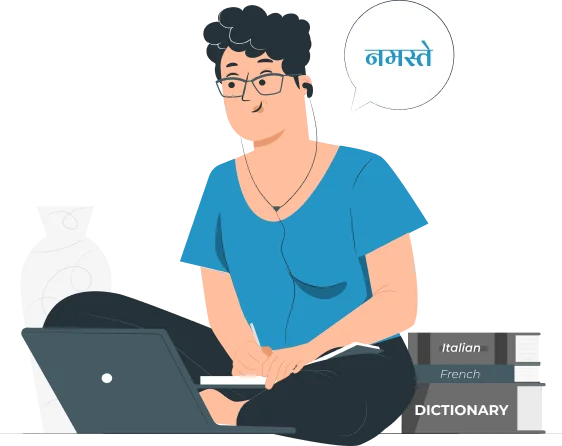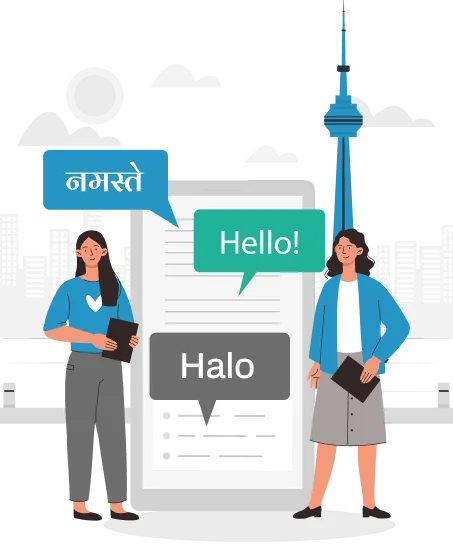Hindi Translation Services
Our professional Hindi translation services are tailored to serve your business objectives in the foreign Indian market. We eliminate language barriers and help you engage with Indian customers more effectively. Get Free Consultation!Get your quote

Comprehensive Hindi Translation Services by Experts
At CCJK, we have skilled Hindi translators with high proficiency in Hindi. They are well-versed in the cultural nuances of India and provide tailored translations for every industry. From IT product localization to engaging Hindi website translation services, we have the expertise and resources to meet the translation needs of our clients for the Indian market. Contact CCJK to get a free quote for Hindi translation services for your project.
Our clients
World’s top organizations rely on CCJK
Nuanced Hindi Translations to Capture the Indian Market
Hindi is the official language of India that offers businesses a vast market to tap into. However, effective penetration requires more than just literal translation. Our nuanced Hindi language translation services ensure your message resonates authentically with the Indian audience. By understanding regional dialects, cultural sensitivities, and local expressions, we create translations that connect deeply. Our expertise in various industries allows us to tailor content to specific demographics, which leads to high brand visibility and reach.

Request a Free Hindi Translation Quote

English to Hindi Translation Services by Native Translators
We make sure your message resonates with the Indian audience through our native Hindi translators. With an understanding of the Hindi language’s nuances, dialects, and cultural context, they deliver English to Hindi translations that go beyond word-for-word conversions. Our native experts keep the original meaning and tone of your content intact. It helps you build trust in the target market and enhance the overall brand reputation. Contact CCJK and experience the difference of working with an expert Hindi translation agency that truly understands Hindi.
Industry Specific Hindi Translation Solutions
Partner with us to achieve your business objectives through effective translation solutions tailored for your industry. Our expertise in industrial terminologies allows us to ensure accuracy and precision. It also prevents errors and the need to rework. Following are some high demand industries we cater to.

Video Game Translation
Translate your video game subtitles and in-game text into Hindi to enhance your game’s accessibility and engagement for Indian players. Get premium video game translation services by certified Hindi translators.

Healthcare Translations
We keep our clients’ medical information confidential and meticulously translate their healthcare documents. Our experienced linguists are proficient in medical terminology and provide Hindi translation service with utmost precision.

Software Translations
Our translators have an in-depth understanding of both the language and technology to provide the best-in-class software translation services. We seamlessly translate all software elements and technical documents to enhance its accessibility in India.

Legal Translations
We understand legal concepts vary significantly across countries, and we have the expert linguists to help you get away with the legal complexities while translating your documents. We save you from legal disputes and keep everything confidential.

Multimedia Translations
We provide culturally nuanced translations for your multimedia content, including marketing material, e-learning content, movies, and social media videos. We support a range of formats and provide seamless Hindi subtitling services for videos and audios.
Partner with Us for Your Hindi Translation Needs
Onsite & Remote Hindi Interpretation Services
Are you looking for an onsite interpreter for a business meeting, international conference, or legal proceeding? Or, do you prefer the convenience of remote interpreting for virtual events or teleconferences? CCJK is a reliable interpreter service provider company that got you covered. Our qualified interpreters have the experience and certifications to work in various settings to ensure effective communication with clarity. We focus on accuracy, confidentiality, and cultural sensitivity and provide tailored Hindi interpreting services to meet your specific needs.

Why Clients Trust CCJK as a Reliable Hindi Translation Company?
Since 2002, CCJK has been helping global businesses accelerate their growth in foreign markets and engage better with overseas customers. Here, you’ll get premium quality English to Hindi and Hindi to English translation services at best rates.

Quick Delivery
Delays in translations can interrupt your business operations, that’s why we prioritize on-time delivery for all our translation projects. Our optimized workflow and experienced project management team ensure that you receive translations within the scheduled timeline.

Quality Controls
We follow a multi-layered QA method to ensure accuracy of our Hindi translations. Our experienced editors and proofreaders carefully review each document to make sure that there are no linguistic inconsistencies and grammatical mistakes.

Flexible Pricing
Every client has their own project requirements and budget constraints. That’s why we keep our pricing flexible to cater to diverse client demands. Whether you need a one-time translation or ongoing language support, we’ll tailor your project package accordingly.

Tailored Solutions
Our team of translators works closely with you to understand your specific needs, growth objectives, and target audience. At CCJK, we customize file formats, industry-specific terminologies, and style guidelines for every translation task.
Different Aspects of the Hindi Language
Hindi is spoken by more than half a billion people worldwide. Its intricate structure, cultural significance, and rich vocabulary make it a fascinating language. In order to comprehend and translate this language effectively, it’s important to first understand its various aspects.
| Aspect | Description |
|---|---|
Script |
Devanagari, a syllabic abugida |
Language Family |
Indo-Aryan, part of the Indo-European language family |
Dialects |
Numerous dialects, including Awadhi, Bhojpuri, Braj, and Marwari |
Official Status |
Official language of India and one of the 22 official languages of India |
Number of Speakers |
Around 345 million native speakers worldwide |
Grammar |
Subject-object-verb (SOV) word order, rich verb conjugation system |
Vocabulary |
Extensive vocabulary derived from Sanskrit, Persian, Arabic, and English |
Writing System |
Right-to-left writing |
Cultural Significance |
Deeply rooted in Indian culture, literature, and philosophy |
Challenges for Learners |
Complex grammar, tonal variations, and different scripts for regional variations |
Meet Our Team of Hindi Translators
Our team of highly skilled Hindi translators brings a wealth of experience and expertise to every project. Native speakers with a deep understanding of Hindi culture and nuances, our translators ensure accurate, culturally appropriate, and impactful translations.

Alok Sharma
With a strong foundation in law and finance, Alok excels in translating complex legal and financial documents. His in-depth knowledge of Indian legal and financial systems ensures accurate and precise translations.

Priya Desai
A qualified medical hindi translator, Priya possesses extensive experience in translating medical research papers, clinical trial reports, and pharmaceutical product information. Her expertise guarantees accurate and culturally sensitive translations in the healthcare sector.

Meera Gupta
Meera brings a creative flair to her translations, specializing in marketing and advertising materials. Her ability to capture the essence of the original message while adapting it to the Indian market makes her an invaluable asset for businesses looking to expand their reach.

Nikhil
Nikhil is a highly proficient IT translator with a deep understanding of software localization. He excels at translating software interfaces, user manuals, and technical documentation, ensuring a seamless user experience for Hindi-speaking audiences.
Our Client Testimonials
Listen to what our clients have to say about us. Their valuable feedback speaks volumes about the quality of work we do.
Your IT translation services were instrumental in localizing our software for the Indian market. The translations were accurate, culturally appropriate, and delivered on time. We're very satisfied with the outcome.
Akiko Tanaka, Product ManagerWe required a reliable partner for our medical document translations into Hindi. Your team's expertise and attention to detail were outstanding. We're confident in the quality of the translated materials.
Peter Schmidt, Research DirectorWe needed to translate complex engineering manuals into Hindi for our Indian clients. Your team's technical expertise and language proficiency were impressive. The translated documents were clear, concise, and easy to understand.
François Dubois, Engineering ManagerWe needed our marketing materials translated into Hindi for our Indian market expansion. Your team did an exceptional job in capturing the essence of our brand while adapting the content to resonate with the local audience. We're thrilled with the results!
David Carter, Marketing DirectorYour legal translation services were crucial for our business operations in India. The accuracy and precision of the translated legal documents were impeccable. We highly recommend your services.
Maria Hernandez, Legal CounselFAQs
frequently asked questions

Do you provide revisions for the translated content?
We prioritize content quality and client satisfaction above anything else. Projects can sometimes require adjustments based on client feedback. Our clients can contact us anytime for translation revisions to meet their goals.
Can you provide references or case studies for similar translation projects?
Yes, we can provide references and case studies for similar translation projects. Please check out this page or contact us directly, and we’ll be happy to share relevant examples that highlight our experience and success in handling projects like yours.
How do you handle confidentiality and data security?
We take proper security measures to keep our client data confidential. All the translators involved are required to sign an NDA before working on your project. We use secure methods to transfer our documents, and only authorized personnel are able to access client files.
How do you maintain language consistency in a large-scale translation project?
In order to effectively manage large-scale projects, we develop a comprehensive style guide with terminology and determine the right tone for the target audience. It reduces the chances of inconsistency and variations throughout the translation project. We also use a centralized TMS to manage people and resources, which confirms that everyone refers to the same resources and project glossaries.
Do you offer industry-specific official Hindi translation services?
Yes we do. With more than two decades of language industry experience, our certified Hindi subject-matter experts are always ready to provide industry and dialect-specific Hindi document translation services. If you need Hindi translations for medical, legal, or any other industry, feel free to contact us anytime!
Can I discuss my translation project with someone by phone?
Yes, you can discuss your Hindi translation project-related queries with our sales team and project managers on the phone.